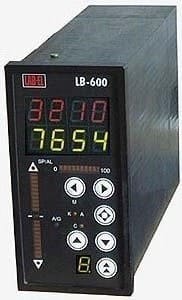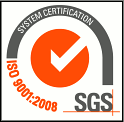| UNIVERSAL MICROPROCESSOR
REGULATOR LB-600 |
| Characteristic |
Description |
Comments |
| Power supply |
85...250Vac. 90...385V/DC or 24Vdc |
|
Powering of the external devices (i. e. measurement
converters)
|
24V dc 500 mA |
Overload protection with a start after overload stopping |
| Casing (overall extensions) |
Vertical: 144 x 72 x 209 mm |
|
| Number of the analogue inputs |
Up to 30 (possibility of operating another 10 inputs from
second and third package if one resigns from the binary input/ output
packages or the analogue outputs)
|
Additional analogue inputs packages can be used if one
resigns from the binary input/ output packages or the analogue outputs
packages)
|
| Number of the binary inputs |
Up to 24 (possibility of operating next 8 inputs from second
and third package if one resigns from the input packages or the
analogue outputs) |
Voltage 16...25Vdc or 3...9 Vdc or short circuit
(optoseparation)
|
Number of the binary outputs
|
Up to 18 (possibility of operating next 6 outputs from second
and
third package if one resigns from the input packages or the analogue
outputs) |
Transmitter contacts (4 switch-over, 2 short circuit switch)
|
Number of the analogue outputs
|
Up to 4 (possibility of operating next 2 outputs from second
package if one resigns from the binary input/ output or the analogue
outputs) |
Optoseparation, current source load carrying
capacity 750
ohm |
Type of the analogue input signals
|
Current, voltage, temperature PT100, Ni100 or thermocouples:
R,
S, B, J, K, E, N, T, resistance
(potentiometers) possibility of cooperation with the probes for
temperatures and humidity measurement produced by the LAB-EL company
equipped with a digital current loop interface
|
Measurement scopes, types of the signals, type of the
sensors,
threshold programmed by a user |
Types of the binary input signals
|
Voltage 16...25Vdc or
3...9 Vdc as logical states 1 or 0 or
short circuit signal (max. 100 Ohm)
|
|
Type of the analogue output signals
|
current (4...20 mA), voltage (1...5V) or 0...20mA/0..5(10)
V |
One output operating non-zero signals such
as 4...20mA (1...5V) other operating zero such as 0...20mA
(0...5 (10))V |
| Accessible regulation algorithms |
PID, PID RATIO, PID RATIO BIAS, PID NL1, PID NL2, PID
prediction,
PID Fuzzy, self-tuning, regulation of open/ close systems etc. |
Possibility of the special algorithms realisation upon a
request
and based on data from a client
|
| Regulation types |
Continuous two-joint and tree-joint (with a position
and/ or stepping feedback – a method used for counting time to take
over an
execution element) |
|
| Additional functions |
Structure and password deletion, scaling clocking, BACKUP
function,
feed forward, tracing one of the input signals, mathematical
multi-argument processing of the input signals, filtration according to
few algorithms types, special algorithms for sugar industry, heat
engineering, arithmetical library functions, logical and time,
possibility of special functions realisation worked out based on a
special client requirements etc. |
|
Communication with a computer system |
RS485/RS422 i S300 |
Cooperation with a computer system using a converter
RS232c/RS485
|
Transmission protocol
|
MODBUS RTU |
Purposely PROFIBUS
|


